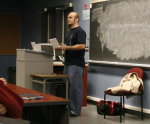Asus eeePC - My Thoughts
 In the last entry I promised that I would write more about my thoughts
regarding the eeePC. As mentioned, I have been involved with the project for
quite some time, having worked on the software that ships with the units
since day one. There was always the geeky temptation to write something
here, but practical considerations (aka "NDA") kind of got in the way.
In the last entry I promised that I would write more about my thoughts
regarding the eeePC. As mentioned, I have been involved with the project for
quite some time, having worked on the software that ships with the units
since day one. There was always the geeky temptation to write something
here, but practical considerations (aka "NDA") kind of got in the way.
From my point of view, it all started from "Pat, we have a new motherboard from Asus we want you to see to evaluate if our product can run on it." My first reaction was that it was a regular, albeit completely bleeding edge board, that will need some serious driver work to get going. Writing drivers is not exactly my area of expertise. But it quickly became clear that the tiny motherboard sitting in front of me had well-established hardware and was meant for a tiny laptop.
We ended up putting together a demonstration of a possible concept for the product in remarkably short time, and that demo is actually quite close to what ships with the units today, if much less polished. Even then, before seeing what the thing would look like there was a very high energy level amongst those involved with the project. Optimizing a distribution to boot in 12 seconds from BIOS to desktop is a fun challenge. The challenges continued right up the stack, and the software is quite true to the Unix philosophy of "one tool for one job," as there are many simple GUI programs that are designed to do one task as simply and quickly as possible. That alone really is quite refreshing.
The enthusiastic energy not only continued, but boosted significantly when the first full unit came in. It was only subtly different in appearance from what ended up shipping. I was impressed, and still am. The tiny laptop is cheap, jam-packed with features, surprisingly ergonomic, and feels more solid than one might expect.
One of the things that Asus did very intelligently with a computer this size is to not over-embed. In other companies there may have been some pressure to make it a PDA-like device. However, the laptop is a standard PC, and the user is free to install whatever OS and software they like. The default software is optimized for the unit, and thus encouraged, but there is no locking in. The default installation contains many hacker-friendly features like quick access to a shell, a full suite of GNU/Linux utilities, even all of the man pages that come with them. At the very least it makes one of the most portable ssh terminals, and at the most, it introduces potentially millions of people to Linux.
At this point, after solid effort on the eeePC project, including many late nights, weekends, and a trip to Taipei, I am very happy with how it's being received. There are generally very positive reviews. Most people are not making the mistake of comparing it to a full-sized laptop in terms of capability; obviously, its small size does bring about some limitations; no surprise there. It's actually the #1 selling laptop on Amazon.com at the moment, which certainly speaks for itself regarding its success. There is even a thriving user community.
As for me, I am simply proud of my contribution.

